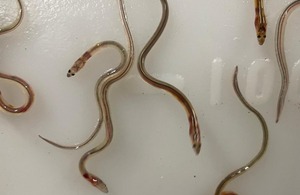Eel travel around Somerset made easier
Natural England teams up with Parrett Internal Drainage Board to ease eel travel around the Somerset wetlands ditch network with a dozen new passes.

Somerset is an important destination for glass eels as they arrive in the Severn Estuary in large numbers each spring, swimming inland via the River Brue and River Parrett. Photo credit: Geoff Carss and Vanessa Becker-Hughes
Endangered eels have been given a boost in Somerset thanks to a project to install a dozen passes to helps them move around the extensive ditch network of the Somerset Levels wetlands.
The project, funded by Natural England, is being carried out by the Parrett Internal Drainage Board. Water control structures are essential for maintaining the right water levels for farming and nature, but they are also significant barriers to eel movement. The eel passes act as ladders that allow eels to swim up over weirs and more easily through the rhyne and and ditches and access the habitat they need to survive.
What is a glass eel?
Glass eels are small and translucent young eels which swim to Europe from their breeding grounds in the Sargasso Sea - a journey of 4,000 miles. Here, in Europe’s rivers and wetlands, they mature and grow up to 1m long before making their long return journey back to their breeding grounds.
Over the last 40 years, the number of European eels arriving in Europe has fallen by around 95 per cent. Somerset is an important area for them in England, as they arrive in the Severn Estuary in large numbers each spring, before swimming inland via the River Brue and River Parrett. They are part of the county’s cultural heritage and a key component of the aquatic food chain and ecosystem.

One of the eel passes with a ramp for young eels, called elvers, to reach new areas of their habitat. Photo credit: Phil Brewin
A big threat to the eels is manmade structures in watercourses that act as a barrier, blocking the eels’ movement through the rivers and ditches. This prevents them from moving to the upper reaches of the rivers which they rely on in order to grow and complete their development.
Making the wetlands eel friendly
Now 12 eel passes are being installed as part of the Somerset Coast, Levels and Moors Nature Recovery Project in the North Moor and King’s Sedgemoor areas to help the eels complete their journey. The ramp-like structures are fitted to existing tilting weirs to provide a surface and route that the elvers (the young eels in between the glass and mature stages) can climb to access new areas of their habitat.
Simon Phelps, project lead for Natural England, said:
Eels are a fascinating species and we’re lucky to have them in Somerset.
They need our help to survive, so it has been great to be able to work with the Parrett Internal Drainage Board to deliver some practical actions for them.
We hope to be able to do more of this type of thing in the future, to make the Levels and Moors a more welcoming place for this special creature.
Phil Brewin, drainage board ecologist, said:
With Natural England’s help the drainage board is fitting eel passes to water control structures to help eels to access the extensive ditch network of the Somerset Levels.
Eel is an important species for Somerset and working with local partners and communities to help restore eel populations on the Levels is a priority for the Drainage Board.
This work will continue and, in combination with other conservation actions, we are confident that the decline in eel numbers experienced in recent decades can be reversed.